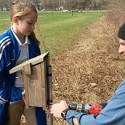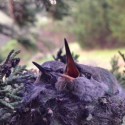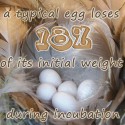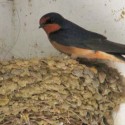 Photo ©
Keith Williams
Photo ©
Keith Williams

Our First Photo Contest
Are you watching nests? Take photos and win prizes! For the month of July, enter your photos of nests here for chances to win. Entering is easy, just upload one or more photos of the nesting cycle to any or all of these categories, including Beautiful Eggs, Cutest Baby, Feeding Time, and Best Nest! And while you’re taking photos, become an official NestWatcher and record what you’re seeing in our scientific database! Contest starts July 1! There will be prizes awarded to the entry with the highest vote in each category along with a first and second overall prize.

NestWatch Inspires Fifth Graders
This year [2014], 5th-grade students at Comstock STEM Academy in Kalamazoo, Michigan, joined America’s largest team of nest researchers when they joined NestWatch. As their capstone project, they learned the nest monitoring protocol for participating and started contributing data to NestWatch.
Michigan State University donated 10 nest boxes to be placed along the perimeter of the school playground. These nest boxes were designed to attract House Wrens and Black-capped Chickadees, which they very soon did. Cara Kreig, of Michigan State University, worked closely with teacher Mary Grintals to train students on safely finding and monitoring nests, because students don’t want to inadvertently cause harm to a nest.
Ms. Grintals relayed that her students were very excited and also deeply respectful when they first discovered a nest in one of the boxes–a chickadee’s nest lined with downy soft materials! A hush fell over the group as the adult chickadee returned to its nest and cast a watchful eye over the students, who were taking coordinates at the time. They departed as soon as they could, leaving the nest in peace. Who would have thought a group of exuberant 5th graders would fall silent in the presence of a single chickadee? (The chickadee, in case you were wondering, went on to successfully raise seven young.)
Several of the students have also begun searching out and finding open-cup nests too, like that of the American Robin. Referring to one particularly eager boy, Grintals remarked, “He has come alive to science doing this project!” Indeed, if we educate young people about the living world out there, how can they not come alive when they find that everywhere, at all times, birds are sharing lessons with us?
Do you incorporate NestWatch into your curriculum? If so, your class could win binoculars from Celestron.
Using NestWatch to get your students interested in nature makes you eligible to win up to 20 binoculars from our Birdsleuth K-12 program. Just submit your activities to the Action Map to be considered. Get the full details. Not sure how to get started teaching citizen science? Get prepared with a webinar.

Coming Soon, Our First Photo Contest
The quality and quantity of photos and videos submitted by NestWatchers to our online photo gallery is only getting better each month since its inception in January. What fun it is to log in and see what new and interesting things this community is watching, learning, and doing.
These photos also serve their purpose, making our newsletter and Facebook page more informative, running alongside news articles that feature NestWatch, serving as a place for discussions to happen and, eventually, will be incorporated into our permanent Lab-wide digital specimen collection. One day, they may even be the basis of a research project.
More than 500 photo and video submissions have already been accepted. To get even more people involved, we’re hosting our first ever photo contest within NestWatch. Gather your favorite nesting images and watch for the announcement on our Facebook page or on the NestWatch home page. Don’t have any nesting photos? There’s still time to find active nests by searching around your home, garden, or hedges. Read our tips on safely photographing nests.
The Home Tweet Home NestWatch Photo Contest is coming July 1, so get ready. Fun prizes, cool birds, and helping NestWatch…what more could you want?

What Loses Weight While Growing?
Did you know that as an embryo grows within an egg, the egg actually loses weight? Why? The egg loses water through its shell constantly throughout the incubation process. A typical egg loses about 18% of its initial weight during incubation, regardless of its size and incubation period. If only it were as easy as breathing for the rest of us.

Data Entries Increase
The year-to-date data entry rate is up 7.3% from this time last year. We’re so excited to see more people engaging with the nesting birds in their neighborhoods.
The previous annual record for Barn Swallows has already been broken, with plenty of time still left in the breeding season. This bodes well for our pilot study of the effects of light pollution on nesting Barn Swallows.
Everything we do comes back to the data, and using your data to study birds. Thank you for helping us grow!